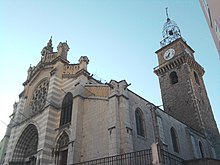Digne Cathedral
The cathedral of Digne in the highly provincial city of Digne-les-Bains in the south of France is a church building of the Roman Catholic Church . It is subordinate to the patronage of Hieronymus (Saint Jérôme) , one of the four "Latin" church fathers , and was classified as a Monument historique as early as 1906 .
history
Allegedly, Digne had been a bishop's seat since the 4th century . Due to the local division of the city in the Middle Ages into an elevated castle district (bourg) and a settlement grouping around it (cité) , the old and too small cathedral of the castle district ( Cathédrale Notre-Dame du Bourg ) fell into the sidelines in the 15th century. At the end of the century a new building was built, the north side of which was opened in the 17th century by side chapels . In the years 1846–1862 the building underwent further profound changes by the architect Antoine-Nicolas Bailly , a student of Viollet-le-Duc - so the entire west facade was extended by a yoke and redesigned.
architecture
The church, built in the 15th century, has three naves; the central nave is raised compared to the two aisles, but not independently illuminated. The pointed arch windows of the polygonally broken apse are without tracery ; the tracery of the side aisle windows shows influences from the early Renaissance . The entire interior of the church, including the round pillars without capitals on which the belt arches and vault ribs rest, is plastered and covered with joint paintings . Around the middle of the 19th century the west side was extended by a yoke and redesigned in a Romanesque - Gothic mix of styles. The tympanum field shows Christ as the judge of the world in a mandorla carried by the four evangelist symbols ; on Trumeaupfeiler there is the figure of St. Jerome.
Root Jesse window
While the visible stones of the church are precisely carved, the tower - with the exception of the corner stones - consists of rubble stones. It ends in a wrought-iron bell cage, which is typical of the region .
Furnishing
The listed equipment includes numerous reliquary containers and other church equipment ; the glass paintings all date from the 19th century (see note 1).
The great organ (Orgue de tribune) was built in 1865 by the organ builder Cavaillé-Coll and was last restored by the organ builder Simon in 1994. The instrument has 21 stops on two manual works and a pedal. The playing and stop actions are mechanical.
|
|
|
||||||||||||||||||||||||||||||||||||||||||||||||||||||||||||||||||||||||||||
- Coupling : I / I (sub-octave coupling), II / I, I / P, II / P
See also
Web links
Individual evidence
Coordinates: 44 ° 5 ′ 31 ″ N , 6 ° 14 ′ 9 ″ E







